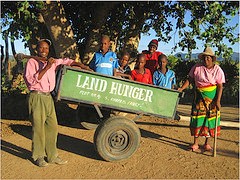
26 September 2011 – Ian Scoones
Zimbabwe’s political crisis continues with political parties’ internal divides exposed by Wikileaks revelations, the coalition government at loggerheads on fundamental issues and the prospect of a violent election period in the coming year. Yet with the stabilisation of the currency and the overhaul of some key economic policies, the agricultural economy in particular has begun to recover. IDS research has been tracking what has been happening in one province since 2000, looking at the changing livelihood prospects of those who gained land in Zimbabwe’s controversial ‘fast track’ land reform programme.
Today a series of short films are released which provide insights into what is happening on the ground, by offering some voices from the field. Following an overview film, each of the films in the series provides a profile of a particular farm family, exploring how they have invested in the land and their visions for the future. The films are accompanied by two booklets which offer a summary of the wider research findings published in the book Zimbabwe’s Land Reform: Myths and Realities.
{loadposition zimbabwe}
Over the last decade land reform has radically reconfigured the agrarian structure, with major impacts on production. This was made worse by recurrent droughts and the withdrawal of external finance and investment. Yet, with the stabilisation of the economy from early 2009, and the adoption of the US dollar as the currency, there has been substantial recovery. The agricultural sector is expected to grow by 19 per cent this year, on the back of a strong 9 per cent growth in the economy as a whole – although of course from a very low base. For example, cotton production is booming, tobacco sales were expected to exceed 170m tonnes, and the output of maize, the staple food crop, has steadily grown despite recurrent droughts. And nearly all of this is from small and medium scale farms. The World Bank’s country economist, Praveen Kumar, observes: ‘The revival of agriculture goes against commonly held wisdom…. smallholder agriculture appears to be moving’. Yet, he comments, ‘economic success is still being held back by political wrangling’.
The headline statistics of course only reveal part of the story. They refer only to products marketed formally, and ignore much that is going on in the rural areas where new farmers on the ‘fast track’ resettlement areas are producing for their own consumption, and marketing products informally through diverse channels. It is only with a more detailed look at what is going on in particular places that a more accurate picture of the impacts of land reform can be gained, moving beyond the standard narrative of collapse and catastrophe.
For example, the research in Masvingo province over the past decade has found that:
- Smallholder farmers are investing in their new farms, estimated at around US$2000 per farm over eight years since settlement
- Production is increasing, with around two-thirds of farms producing enough grains to feed their families for a year, and around a third selling surplus grains in good seasons
- Around half of all farms are doing well, producing consistently and ‘accumulating from below ‘through investment in field improvements, farm inputs and livestock
- Around a third of farm families are however struggling, and having to diversify their livelihoods, including selling labour to more successful farmers.
Our research continues to follow the fortunes of the 400 households in the study sample, all of whom gained land under the land reform programme. They are distributed across 16 sites in Masvingo province, ranging from relatively high to very low potential areas, and including both small-scale farms and medium scale commercial units. It is a very dynamic picture. Each season is different, and the changing political and economic context of the country results in complex twists and turns.
While there has undoubtedly been abuse, corruption and the exercise of party political patronage in the implementation of the land reform programme, this is not the only story. There have been successes as well as failures, and according to the research many of the small-scale farmers who gained land are ‘accumulating from below’ – investing in the land, and increasing production – and so contributing to Zimbabwe’s slow agricultural recovery.
For more information on the research, including videos, photos, media comment, book reviews, blogs and more, see our new website at www.zimbabweland.net, dedicated to sharing the results of the work.
Professor Ian Scoones is an IDS Research Fellow and Director of the Future Agricultures Consortium.
